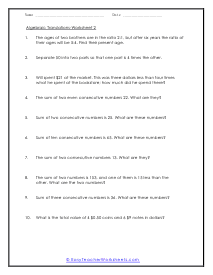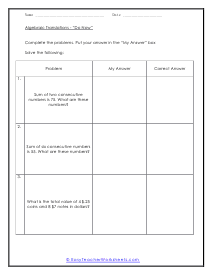These worksheets help you learn how to convert word problems into algebraic equations and then manipulate the values to make better sense of the data that may be available. This is an essential skill as that will help you tackle all types of math topics. Two complete sets of worksheets introduce your students to the concept of deriving algebraic equations from context word clues, provide examples, short practice sets, longer sets of questions, and quizzes. This will be a challenging, but super rewarding section for students to siphon their thoughts through. The worksheets will help your students understand the relationship between statements involving numbers and the algebraic equations these statements represent.
Print Algebraic Manipulation Worksheets
Click the buttons to print each worksheet and associated answer key.

Algebraic Representation Lesson
Learn how to turn mathematical statements into algebraic expressions. Example: "Ten more than five times a number" = 10 + 5x

Equation Manipulation Worksheet 1
Create algebraic representations from these 10 statements. You will then be able to move things around in algebraic form.

Worksheet 2
Describe these problems using algebra. An example would be: Four more than five times a number. Solved: If we let x represent the number, the answer would be: 4 + 5x.

Review Sheet
Practice creating algebraic representations from these 6 statements. You can take this a step further and rearranging the equations.

Do Now Sheet
Use each of the statements and rewrite them using algebra. Then put your answers in the "My Answer" box.

In Action Lesson
Learn how to solve the problems using what we have learned so far. Here is an example problem: "The sum of two consecutive numbers is 11. What are they?"

Algebraic Translations - Worksheet 1
This worksheet has ten statements that must be turned into algebraic expressions. Example: "Separate 49 into two parts so that one part is 6 times the other."

Worksheet 2
This one is all about algebraic expressions. You will create them and then make sense of them.

Review Sheet
Practice creating algebraic expressions from these 6 statements. You can show multiple versions of the statements.

Algebraic Translations Quiz
This worksheet has ten statements that must be turned into algebraic expressions. Example: "What is the total value of 20 $.50 coins and 3 $10 notes in dollars?"

Do Now
Make an algebraic representation of each statement and put your answer in the "My Answer" box.
What is Algebraic Representation?
Often in mathematics, one encounters a quantity or an object that is too difficult to analyze or understand. In these cases, it can be helpful to construct a representation for the object that makes its properties clear. Algebraic representation is a tool that allows us to create equations that describe objects and relationships.
Why is It Important?
Algebraic representation is a method of representing mathematical relationships using symbols. In algebra, these symbols usually form letters or other variables. This allows us to solve equations and understand concepts in a more abstract way. This type of notation is essential because it allows us to manipulate equations and solve problems we could not otherwise solve.
It is a powerful tool that you can use to solve problems in many different areas of mathematics. For example, we can use algebra to represent points, lines, and shapes in geometry. In physics, we can use algebra to represent motion and energy. Modeling situations with algebra is a fundamental tool in many scientific disciplines.
Additionally, you can use algebraic representation to represent real-world situations mathematically. For example, we can use it to model how different variables interact with one another. Finally, this is important because it is a powerful tool for solving problems and discovering new information.
Types of Algebraic Representation
There are many different forms, such as equation, function, graph, and vector, each with advantages and disadvantages. We will take a closer look at some of the most common types of algebraic representation:
Equations
One of the most basic types is the equation. An equation is a mathematical statement that two things are equal. For example, the equation x+3=5 can be read as "x plus 3 equals 5." Equations can represent simple mathematical problems, such as finding the value of x in the above example. However, you can also use them to describe more complex problems, such as solving for x in a quadratic equation.
Functions
Another common type is the function. A function is a mathematical relation between two variables, usually denoted by an equation. For example, the function y=x+3 can be read as "y equals x plus 3." Functions can represent many different types of mathematical problems, such as finding the slope of a line or determining the roots of a polynomial equation.
Graphs
Perhaps the most common type is the graph. A graph is a visual representation of a function or an equation. Graphs can represent many mathematical problems, such as finding the intercepts of a line or determining the maximum and minimum values of a function.
Vectors
Finally, we have the vector. A vector is model of a quantity with both magnitude and direction. Vectors can represent many mathematical problems, such as finding the force exerted by a moving object or determining the velocity of an object.
Using Manipulation
Once we have modelled a situation or scenario by using algebra it allows us to understand the system that it represents in many different ways. This is especially true of algebraic equations. If a variable or series of them exists in the equation, we can manipulate those variables by increasing or decreasing their values to observe the outcomes. This helps us understand the nature of these variables.
Wrapping Up
Algebra is a powerful tool that you can use to represent and solve many different types of mathematical problems. As you can see, each type of representation has its advantages and disadvantages. With practice, you can choose the right type, solve equations, and understand functions in no time!


